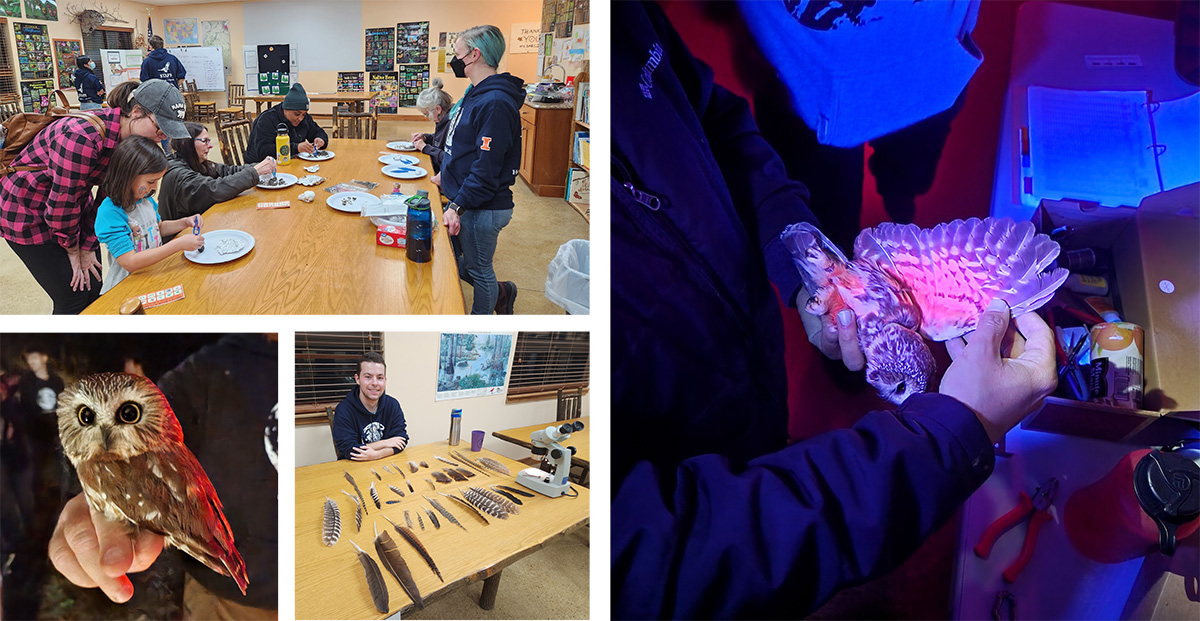Students host Owl Night outreach event for second year, and it’s a real hoot!
Students at the University of Illinois Urbana-Champaign once again hosted “Owl Night,” a public outreach event where people of all ages can learn about owl behavior and ecology, and if they’re lucky, see an owl up close. Owl Night takes place on two separate nights: November 1st at Kennekuk County Park, and November 8th at Homer Lake. At Owl Night, participants can learn about owls through a series of hands-on activities, including dissection of owl pellets, examination of owl feathers under a microscope, tracking owls by hand using radiotelemetry, and more!

The event is created and run by the students of NRES 285: Owl Migration & Education, a class designed not only to teach students about owl biology, but also give them skills in science communication and outreach. The class—currently in its second year—is co-instructed by Joy O’Keefe, an assistant professor and extension specialist of natural resources & environmental sciences, and Michael Ward, a professor of NRES as well.
“The class teaches students about basic biology and ecology of birds, wildlife research techniques, and outreach tactics that you can use to engage the public,” said O’Keefe. “The students learn the components of putting together a big outreach event and deciding what activities they want to run. We encourage them to think about what they really want the public to take away from the event.”
Besides hosting the two public owl nights, students also gather weekly at the Kennekuk Education Center to assist with research on the migration and behavior of Northern Saw-whet owls, which are the smallest species of owl in Illinois. The research is led by Mike Avara, lab manager and field coordinator for Ward’s lab. The research team uses mist nets, which are thin and indiscernible nets stretching 12 meters in length, to safely capture the owls. Owls are then aged, sexed, banded, and tagged with a radio transmitter that utilizes a local tower telemetry system to constantly take spatial data on the owls after release. The project’s original goal was to see if owls use Kennekuk Park as a stopover point during migration. But Avara says that since then, the project’s scope has grown, with new questions arising about the factors affecting movement of owls during migration and potential territorial responses to playbacks.
“First we wanted a systematic way to test for the presence or absence of owls,” said Avara. “Then last year that evolved into more questions about the activity of the owls. Are they staying for extended periods of time, like the entire winter? Or are they migrating further south? This year we’re looking at migratory connectivity, so when and where the owls go, how far they're moving around, and how weather might be impacting that.”
Because the scale of research has grown, so has the need for extra hands and experienced banders to train the students. Mac Chamberlain, a 2nd year graduate student in the lab of Mark Hauber (GNDP), a professor of integrative biology, joined the team last year as a field coordinator and educator for both the public Owl Nights and the research nights. Chamberlain previously banded raptors at Cedar Grove Ornithological Station before attending Illinois, and now helps train the students on handling and banding the owls.
“I like introducing the students to owl banding because owls are very charismatic birds,” said Chamberlain. “At the first station that I worked at, we always called them ‘killer sky kittens’, because they’re cute and fluffy but have quite dangerous talons. Teaching people about owls can really get them hooked on birds.”
Through their owl tracking efforts, the researchers have found that although the owls move all around the park, they do have specific roosting spots they prefer. Interestingly, these spots change occasionally over the season, and this seems to coincide with loss of leaf cover in their roosts. Researchers also found that the owls were most active at dusk and dawn, but still moved around throughout the day. Out of the owls caught, 80% were female, matching patterns seen at other stations, and eliciting new questions about the reason for a female-skewed sex ratio during migration.
O’Keefe and Ward plan to keep offering the class each Fall, and hope to have future students learn how to analyze the owl data they collect, and run a social media campaign to advertise the public event and communicate research findings. O’Keefe also hopes to get more historically excluded groups involved in the research and outreach components. Avara says there is much more research to be done with the owls, and that he hopes that both the outreach and research of owls at Kennekuk continue to grow.
Erin Wunderlich, a senior undergraduate, says the class merges her interests in environmental science and science communication, and gives hands-on experience that is important for her career ambitions.
“This experience has been eye-opening because not only do we learn all these things about owls and outreach, but we actually get to do the public event ourselves and see the results,” said Wunderlich. “It's really amazing.”
“Working with the students and the public, watching that interest in birds and science grow in the community…I think is my favorite part.” Chamberlain said.
